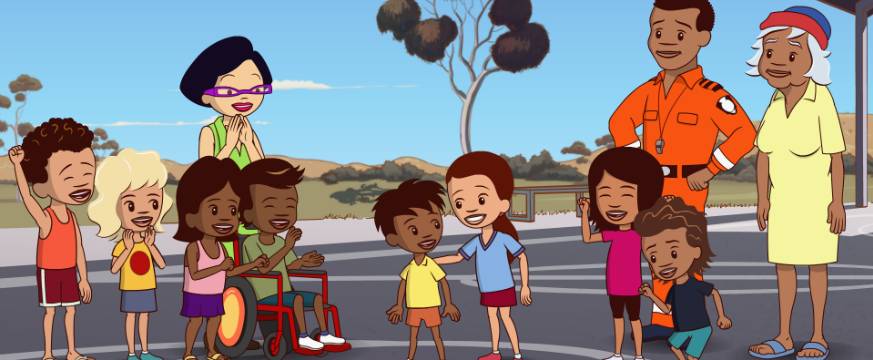
From inspiration to award win: Little J & Big Cuz’s journey to the Logies
Research 9 Jul 2018 6 minute readFollowing its 2018 Logie Award win, we take a look back at the ground-breaking children’s animation, Little J & Big Cuz.
It took Lisa Norris, Director of the ACER Foundation at the Australian Council for Educational Research, and project partner Ned Lander Media more than eight years to bring the first animated TV show starring Indigenous children – winner of the 2018 Logie Award for ‘most outstanding children’s program’ – to Australian screens.
As part of ACER’s School Readiness Initiative, the series is designed to help Indigenous children get a better start in their formal schooling by modelling the day-to-day running of an early primary classroom. The series follows lead characters Little J (voiced by Miranda Tapsell) and Big Cuz (Deborah Mailman) as they enjoy common school experiences like show-and-tell, lunch breaks and school performances. Series one has been embraced by children and communities all over Australia.
The concept of the program is rooted in research showing that Aboriginal and Torres Strait Islander children in Australia are twice as likely to be identified as developmentally vulnerable, but only half as likely to have access to the kind of early years education programs crucial to preparing children for school. Additionally, there is strong evidence that educational TV programs can play a role in improving school readiness by building literacy and numeracy skills, self-esteem and an understanding of school expectations. But coming up with the idea was the easy part for the team responsible for making it a reality.
‘Everyone we spoke to thought it was a great idea and couldn’t understand why it hadn’t been done before’, Ms Norris says. ‘But ask anyone who has ever tried to get a TV show up and running and they will say it is a huge task, and you have to be nuts to take it on.
‘Fortunately for us, we found partners – all experts in their respective fields who brought a range of unique skills and talents – as passionate about the project as everyone at ACER.’
First to sign up was SNAICC, followed quickly by NITV, Screen Australia, Screen Tasmania, Film Victoria, Dusseldorp Forum and Lotterywest. It was then that the hard work really began; the process of finding Indigenous writers, a director and an animation team fell to Ned Lander. The characters began to take shape at writers’ workshops in Alice Springs, Sydney and Melbourne in 2013, and the educational content of each storyline was aligned with the Australian Early Years Learning Framework by a team of talented Indigenous educators led by Priscilla Reid-Loynes. Ms Reid-Loynes also wrote extensive teaching resources for preschools, assisted by a team of primary educators led by Deborah Cohen that developed more than 300 resources for students up to Year 2 in line with the Australian curriculum and designed for in-classroom use.
‘The best way I could describe this project is as a beautiful challenge,’ Ms Norris says. ‘The series is just one component of a much bigger whole, with the resources being equally challenging to produce, mainly because of their sheer volume.
‘We all felt overwhelmed at times but the team were passionate and produced educational content that is rich and beautiful – and we are very proud of what everyone involved has achieved.’
After the series aired, Ms Norris received this email from a teacher: ‘I teach a “dynamic” and “interesting” group of year ones and twos. They are thirsty for knowledge or starving for a sense of safety. Some of them are both. But every single one of them loves your show… We have used it to unpack social problems, to explain complicated emotions, to learn about safety and to learn of Aboriginal peoples' perspectives and culture. Thanks for giving me a daily 11 minutes of calm to recalibrate, thanks for giving them an authentic identity and narrative to look to, and thanks for giving us a means of exploring our best selves.’
‘If ever there was an email that made it all worthwhile, that was it,’ says Ms Norris. ‘To know we had made a difference to just one classroom of kids justified all the pain of production.’
Little J & Big Cuz garnered broader acclaim by winning the ‘most outstanding children’s program’ category at the 2018 Logie Awards in June, which Ms Norris calls ‘gratifying recognition from the entertainment industry of the value of Little J & Big Cuz, and a compliment to the whole team’. Writers Beck Cole and Erica Glynn have received further acknowledgement in the form of an Australian Writers’ Guild Award (‘AWGIE’) nomination, a coveted marker of peer recognition because they are awarded to writers by writers. Winners are announced in August.
Series one of Little J & Big Cuz was produced by Ned Lander Media and directed by Tony Thorne, revoiced and screened in seven languages (Pitjantjara, Arrernte, Palaw kani, Yawuru, Walmajarri, Djambarrpuyngu and English) and aired on the ABC and on NITV in 2017. Season two is in production and will be screened in late 2019 or early 2020.
An evaluation of the impact of series one on children, schools and communities is being carried out by Dusseldorp Forum and a report is due in 2018.
ACER Foundation thanks these generous partners for helping to bring Little J & Big Cuz to Australian screens:
- SNAICC
- Ned Lander Media
- NITV and SBS
- Screen Australia
- Film Victoria
- Screen Tasmania
- The Australian Children’s Television Foundation.
Further information:
Still haven’t seen Little J & Big Cuz? Episodes, games and teaching resources are available on its website: www.littlejandbigcuz.com.au.